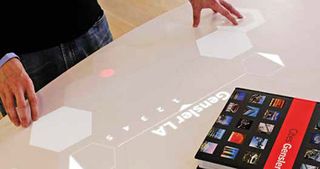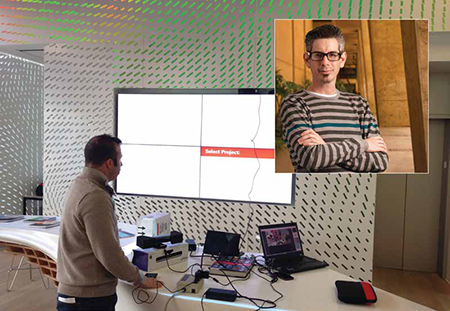Gensler, a global architecture, design, and planning firm, is known for, “delivering projects as large as a city and as small as a task light for an individual desk.” Continuous ideating and innovating around how individuals relate to, and engage in various architectural spaces has led the Gensler experience design team to take a deep and creative dive into the interactive world of digital signage.
“As with all projects of this nature, it takes a group of people to make magic happen,” said Alan Robles, associate, experience designer at Gensler (inset). “Yahav Ran, multi-display expert and co-founder of digital signage and interactive agency, The Hive, and his creative team were instrumental in developing and converting the concept into a tangible experience.” “This whole office is kind of a working experiment,” said Alan Robles, associate, experience designer for Gensler, and instructor for the UCLAx Design Communication Arts program, describing the award-winning, downtown Los Angeles office. In May 2013, the lobby was transformed into an augmented reality experience, called The Hive/Gensler Multi Surface Experience to showcase the firm’s portfolio of work.
“As with all projects of this nature, it takes a group of people to make magic happen,” Robles added. “Yahav Ran, multi-display expert and co-founder of digital signage and interactive agency, The Hive, and his creative team, were instrumental in developing and converting the concept into a tangible experience.”
The magic begins as visitors enter the lobby and walk into an experience that attracts them towards an augmented table and book. Microsoft’s Kinect for Windows cameras interpret the reality of the lobby, allowing the experience to be reactive to its surroundings in real-time, while a Canon REALis WUX5000 projector displays the interface onto the table. A four-panel, 4K, Planar Clarity Matrix LCD Video Wall System displays digital content from the book using software from YCD. The Hive team developed custom software that enabled the augmented reality components to create an immersive user experience.
THE DIGITAL NARRATIVE
Noting disappointment of how some companies were implementing early digital signage installations, Robles explained: “The content, and the story of how that content and how the technology works in conjunction with the space, was always amiss.” Gensler’s reaction to that was to “leverage the same kind of design thinking that we used to develop the design of the space, and to work technology into that story as a core component of it.”
“We start off with the narrative: the story of how the space is going to work; what you’re going to see; what you are going to smell; and touchpoints about the light levels in the space,” Robles said. “All of the touchpoints work together to create an experience.”

Gensler’s Alan Robles said: “Our end-goal, that golden apple that we are reaching for is, to develop a digital interface for the physical space: a way that you can use your environment to access information and to change your environment, to change your experience.”AN INTEGRATED EXPERIENCE
Even for a firm that has a reputation built on designing spaces, retrofitting an installation such as this comes with its challenges. “We want to further the story of how you can integrate this type of experience within an environment without making it an uncomfortable insertion of an unnatural component,” Robles said. The technology components of the experience are not apparent. “When people visit the facility, they don’t get it right away that there’s a projector hidden up in the lid and that what they are seeing is a projection on a table.”
“It all comes back around to delivering on the narrative,” Robles emphasized, which is why IT is part of the team from the outset, by being involved in the conversations and attending all of the meetings so they understand what’s coming up and what’s involved with executing. “When we did this implementation, there was the need to make sure our development partners had the ability to login remotely, as well as the need to make sure we had enough rack space and the right kinds of lines in terms of Cat-6 cables running to the locations for the Planar displays.”
While hindsight is 20/20, Robles recommends to others that during the building planning process, “If you can work as much of that infrastructure into your building as possible [before the walls go up], it is going to only enable you to make changes down the line in more powerful ways that aren’t going to require you to reinvent the space or reconstruct the space.”
The Gensler/Hive team is currently working on the next phase of the Multi Surface Experience. “We’re going from the Kinect 1 sensors to the Kinect 2 sensors and increase the activation from two people to six people, and we’re going to be able to increase the range and the resolution of what the cameras can track significantly.” Already in hand and ready for installation are Planar’s 84-inch 4K touchpanels. “We’re going to add things like touch, so that while one person is using the table and the projected interface to interact with the videowall, the other person, the host, could be standing at the videowall, answering questions about what the person is seeing as they browse, and also activating content on the display itself by touching different parts of it,” Robles added.
LIVING THE EXPERIENCE WHILE IDEATING
With a network of touchpanel displays throughout the offices, the Gensler teams are not new to digital signage as an experience. “We’re currently developing a system by which active Bluetooth signals on people would allow the display to recognize who you were and then key-up content that you had selected and curated,” Robles confirmed. “Let’s say you are part of the hospitality group, and you were walking a client around the office. You could stop at anyone of these displays that we have, and it would automatically recognize who you were, key-up the content, and let you do an impromptu presentation.”
Ultimately, according to Robles, “Our end-goal, that golden apple that we are reaching for is, to develop a digital interface for the physical space: a way that you can use your environment to access information and to change your environment, to change your experience.”
info
GENSLER
www.gensler.com
THE HIVE
thehivecentral.com
CANON
usa.canon.com/cusa/home
PLANAR
planar.com/
YCD MULTIMEDIA
ycdmultimedia.com
MICROSOFT KINECT
microsoft.com/en-us/kinectforwindows/











